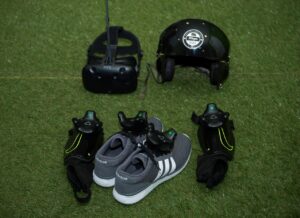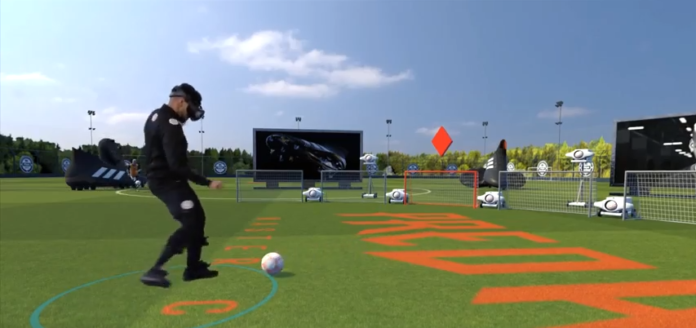Mi Hiepa recently unveiled a simulation game at an adidas Predator event to showcase the company’s newest shoe. Like other VR attraction games, a leaderboard tracked players to benchmark talent. The show was also a live test of what the software could do, simulating pressure testing and advanced ball physics.
Mi Hiepa is a lot like Strivr, but for soccer players to learn better target designation and offer a quick mental warm up. At the professional level, the software helps maintain sharpness between matches. It also aids in player injury recovery with an adjustable difficulty that is never overly taxing on the body.
The futbol simulator uses Vive trackers to simulate ball control. Under the hood, advanced data collection tells coaches where and how to help players. Perhaps focusing on a certain angle, or reacting to a particular pass. The system can use real video, but it’s primarily a video game environment like we’re used to.
Vive Trackers

Although Strivr can work without enhanced tracking, MiHiepa relies on it. The software utilizes specialty shin guards that mimic the feel of a soccer player’s field kit with sensors mounted at the knees and near the ankle joints. The system can tell where and how your foot moves, even how you twist it when you kick. Such dynamic motion capture allows for trick style shots like behind-the-back kicks with relative accuracy. It can accurately detect the power of a strike, as well as foot placement on the ball. It can tell where and how a pass was made, how hard the ball was kicked, whether it should bounce off the ground or was lobbed into the air, and more advanced ball physics.
Fitness Implications and Potential
The developers have an excellent use case for the conventional technology available to all of us. Accurate physics is fundamental to sports simulation at the professional level because physics is fundamental to sports. Some games already offer Vive tracker support, which does add realism and additional functionality. It can make guns, tennis rackets, baseball bats, boxing gloves and more feel highly realistic.
Mi Hiepa developers have created a variable leg workout that genuinely teaches the fundamentals of soccer ball handling. It can grade players with a strong backbone in data collection, and the Vive system is built on technology available to consumers. This simulation is a pretty big deal as VR starts taking off and more prominent developers take notice. Although costs are high for early adopters, they aren’t astronomical. Anyone with a budget can get these systems.
Final Thoughts
[youtube https://www.youtube.com/watch?v=ijOXvDB80e0&w=560&h=315]
Mi Hiepa is bringing analysis and hard data collection to the beautiful game of futbol to improve a professional player’s performance. Its usage of the Vive tracker fuels a powerful data collection tool, and a virtual world with realistic soccer ball physics and shot power. The simulation is highly accurate, and that’s where Mi Hiepa differs from every soccer game on Steam.
The company is doing conventional things unconventionally, offering a professional grade tool packaged within a game experience. Mi Hiepa teaches as much acuity as it does training muscle memory.
We hope this kind of training catches on at the consumer level, or within youth leagues at least because we think it’s valuable training. Utilizing Vive trackers makes Mi Hiepa unique to the Vive, but the costs for a sports organization would be relatively low.











